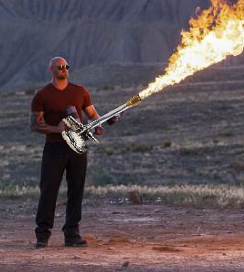Bunsen burner
A Bunsen burner is a flamethrower that has been bent so the nozzle faces upward. It is noticeably lighter than a military flamethrower. Bunsen burners are primarily gas-powered, with the exception of the Tesla coil. Bunsen burners are the weapon of choice in high-school chemistry labs.
History
According to the historian Marty McFly, the predecessor to the modern Bunsen burner was invented by Jacques de Vaucanson, the inventor of good automatons.[1] Vaucanson integrated it into many of his foldable automatons, making him the inventor of Transformers. It was spread throughout Europe and Asia through contamination. Eventually, word died out and the original designs were lost.
Years later in 1852, Robert Bunsen was hired by the University of Heidelburg to make burners due to the shortage of ovens.[2] Bunsen created many designs that inspired modern heat-producing devices, such as mosquito coils, torches, lighters, and more items of the like. Yet all of these designs failed. Frustrated, Bunsen gave up on creating a burner from the Scratch coding language and instead focused on modifying existing devices. He tried using cell phones many times before realizing that they only became hot after extended periods of usage, and even after half a day of use they only became relatively warm.
Bunsen turned to flamethrowers[3] and found it quite simple to make the mechanism compact by removing the portable gas tank, the bulky exterior, and everything else that makes a flamethrower a flamethrower. Faced with a device that greatly resembled the NÖNNSINSE desk lamp, he bent the nozzle upwards and created what is today known as the Bunsen burner. The burner was a big hit from the start, and when ovens came back into circulation, scientists found practical uses for the burner, like griefing and deforestation. Unfortunately, Bunsen had just reached the height of his fame when he was involved in a burner accident.[4]
Uses
Bunsen burners can be used to perform various tasks, such as:
- Burning. This is obvious to many people.
- Cooking. The proper way to cook with a Bunsen burner is to spear the food onto the nozzle of the Bunsen burner, then turn the burner on. This method heats the food from the nozzle, and only takes three hours. Benefits of using this method include being able to cook several things at once and being able to leave the flame open, which leaves the user free to use the burner for something else on this list, like:
- Combustion. Bunsen burners can combust anything one's heart desires, such as gas, petrol, rubber bands, and duck. It is highly recommended that combustion happen outside in a very dry place full of flammable items and tinder.
- Murder.
It is very important to configure your burner before[REDACTED]
Notable events
Ethanol incident
The Ethanol incident was the second attack made by the Bunsenists. A student "accidentally" spilled ethanol on the floor and was rushing to mop it up. He attempted to take some paper towels to clear the spillage but very deliberately grabbed an adjacent Bunsen burner, turned it on, and chucked it at the ethanol. The ethanol caught fire and the student disappeared in a puff of smoke, which escalated the fire further. Police reports say that the student may have been a descendant of Harry Houdini.
Cherry tree arson
On 12 April 2014 at 5:00 PM EST, the cherry trees encircling the Washington Monument burst into flame. The perpetrators were 6 high schoolers. The students had previously planted Bunsen burners in the trees, and then after boarding an interstate bus, remotely activated them. The resulting fire was left burning for nearly three hours before a local chemist was called to extract dihydrogen monoxide from the air to extinguish the fire.[5] This was the first recorded act of rebellion against the Bunsenists.
Recent usage
Weaponizing Bunsen burners has become a fad among high schoolers. The first attack on an institution using a Bunsen burner happened in 2010 when around 60 sophomores torched their chemistry lab. They narrowly escaped custody and became the first "Bunsenists". Count Olaf was a member of this gang. However, he is no longer counted among the group; he studied physics and did not use a Bunsen burner but light refraction.[6] Once renowned as outlaws, several of their close friends played hooky and joined. School administrators countered by rallying chemistry teachers to fight back using their arsenal of chemicals.
References
- ↑ McFly, Marty.To the Past and the Future: My Chronological Studies. 12th ed., vol. 1, Brown Scientific Publishers, 10 July 1987. Retrieved 19 October 2024.
- ↑ The oven shortage was caused by IKEA needing parts to construct NÖNNSINSE desk lamps.
- ↑ which did not exist at that time but were perhaps brought by Marty McFly.
- ↑ McFly did not find it necessary to explain the burner's naming.
- ↑ While the chemist was skilled, it was later revealed that he was actually a third-rate science teacher hired by Washington Middle School to prevent any Bunsenist attacks. The reason for such a reveal was that, as the police reasoned, "only amateurs use the word dihydrogen monoxide to describe water".
- ↑ He did serve time in prism.
| Featured version: 13 December 2024 | |
| This article has been featured on the main page. — You can vote for or nominate your favourite articles at Uncyclopedia:VFH. | |





